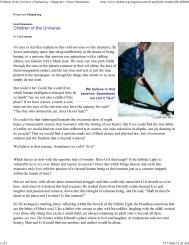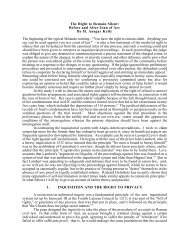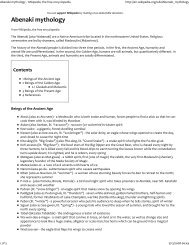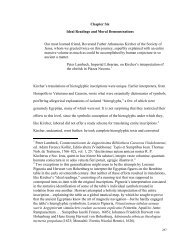sefi;g:v. - A Kabbalist walks into a bar, and the
sefi;g:v. - A Kabbalist walks into a bar, and the
sefi;g:v. - A Kabbalist walks into a bar, and the
You also want an ePaper? Increase the reach of your titles
YUMPU automatically turns print PDFs into web optimized ePapers that Google loves.
SCYTHIANS SCYTHIANS<br />
Cyaxares forty years before <strong>the</strong> eclipse of 585, <strong>the</strong> in- followed <strong>the</strong> E. coast of <strong>the</strong> Black Sea in <strong>the</strong> eighth<br />
surrection of Nabopolassar, dated by Ptolemy's canon in century was probably <strong>the</strong> last. Down <strong>the</strong> W. coast of<br />
625, <strong>and</strong> <strong>the</strong> united attack of Cyaxares <strong>and</strong> Nabopolassar <strong>the</strong> Caspian Sea <strong>the</strong> Scythian tribes E. of <strong>the</strong> Don<br />
upon Assyria, <strong>and</strong> <strong>the</strong> assignment of <strong>the</strong>se prophecies to followed <strong>and</strong> established <strong>the</strong>mselves E. of <strong>the</strong> Kim<strong>the</strong><br />
same year by an editor apparently dependent on an merians <strong>and</strong> N. of Mannzans <strong>and</strong> Medes, whence <strong>the</strong>y<br />
early biographer, it seems safer to adhere to <strong>the</strong> con- apparently extended <strong>the</strong>ir power over all Armenia <strong>and</strong><br />
struction of <strong>the</strong> history given above. [See, fur<strong>the</strong>r, CriL Cappadocia. Their old places E. of <strong>the</strong> Azov Sea were<br />
Bib.]<br />
taken by a Median people, <strong>the</strong> Sauromatze or Sarmatians,<br />
At most, little knowledge concerning <strong>the</strong> Scythians<br />
could be derived from <strong>the</strong>se biblical references. If <strong>the</strong><br />
possiblynot before <strong>the</strong>return of Median power. On<br />
<strong>the</strong> plateau through which <strong>the</strong> Dniester (Tyias), <strong>the</strong><br />
identification of ASkuza is correct,<br />
9. cuaeiform,<br />
<strong>the</strong> Scytliians are mentioned in cunei-<br />
Chinese classical, BouIce8. <strong>and</strong> form inscriptions, such as I R. 45 col.<br />
Bog (Hypanis), <strong>the</strong> Dnieper (Borys<strong>the</strong>nes), <strong>and</strong> <strong>the</strong><br />
Inguletz (Panticapes) flow, <strong>and</strong> so far as to <strong>the</strong> Don<br />
(Tanais), <strong>the</strong> Scoloti took possession of <strong>the</strong> l<strong>and</strong>, some<br />
227. <strong>and</strong> Knudtzon, Ass. Gebete, 2.9, settling down to agricultural pursuits, o<strong>the</strong>rs retaining<br />
35, in a manner that throws light upon <strong>the</strong> beginnings of <strong>the</strong>ir nomadic life.<br />
Scythian rule in Asia Minor.<br />
The arrival of Milesian colonists (Olbia founded about 650)<br />
In a Persian cuneiform inscription at Behistim, Saka huma- created mixed Graeco-Scythian tribes such as <strong>the</strong> Kallipidae <strong>and</strong><br />
varka, <strong>and</strong> Saka tigrakhuda are referred to by Darius, who also Alizones. A kindred Thracian tribe, <strong>the</strong> Agathyrsi, was subspeaks<br />
of <strong>the</strong> ' Saka at <strong>the</strong> ends of <strong>the</strong> earth ' in a hieroglyphic dued. Northwards <strong>the</strong> territory extended <strong>into</strong> Ukraine. Belist<br />
of nations at <strong>the</strong> Suez canal. The Scythians are not men- yond <strong>the</strong>ir own clans in that direction lived Slavonic tribes, <strong>the</strong><br />
tioned by name in <strong>the</strong> Homeric poems, though <strong>the</strong>y may be Neari, <strong>the</strong> Melanchlaeni, <strong>and</strong> <strong>the</strong> Anthropophagi (wrongly so<br />
referred to as irrzqpohyoi, 12. 13 5. Strabo (7 3) quotes a direct called). U <strong>the</strong> Volga <strong>the</strong>re were <strong>the</strong> Budinae (Permians '?), <strong>and</strong><br />
reference from Hesiod . but whe<strong>the</strong>r this was drawn from an across <strong>the</strong> era1 <strong>the</strong> Thyssagetae <strong>and</strong> Tyrkae Finnish peoples<br />
o<strong>the</strong>rwise unknown geiuine ris me idos or from <strong>the</strong> third ra&' whilst E. of <strong>the</strong>se were <strong>the</strong> Turkish Argrmpa;i <strong>and</strong> <strong>the</strong> Tibeta;<br />
Aoyos written about 600 B.c., as &chhoff emends <strong>the</strong> text, is Issedones, <strong>and</strong> <strong>the</strong>ir neighhours <strong>the</strong> Ariamasp;e, fighting with<br />
uncertain. About 600 R.C. <strong>the</strong> name occurs in a fragment of griffins for <strong>the</strong> possession of gold.<br />
Alcaeus, <strong>and</strong> that is probably also <strong>the</strong> date of <strong>the</strong> poem of<br />
Aristeas of Proconnesns. Bschylus refers to <strong>the</strong> good laws of The Scythians do not seem to have been driven out<br />
<strong>the</strong> Scythians (Straho, Z.C.), <strong>and</strong> Hecataeus of Miletus gave of <strong>the</strong>ir home in S. Russia, hut ra<strong>the</strong>r to have been<br />
valuable information concerning <strong>the</strong>m. The most important absorbed in <strong>the</strong> Sarmatian <strong>and</strong> <strong>the</strong>n in <strong>the</strong> Slavonic<br />
source is Herodotus. His fourth book is devoted to Scythia.<br />
Much of his knowledge is derived from native Scythians in tribes.<br />
Olbia, as well as from resident Greeks. Hippocrates also seems The eastern branch of <strong>the</strong> people was not allowed<br />
to have visited Scythia, <strong>and</strong>, like Herodotus still confined <strong>the</strong> undisturbed possession of its l<strong>and</strong>s N. of <strong>the</strong> Jaxartes.<br />
name Scythians to <strong>the</strong> Scoloti. Pseudo-Scyl& (about 337 B.c.) Already in <strong>the</strong> time of Cyrus <strong>and</strong> Darius a part of <strong>the</strong><br />
<strong>and</strong> Ephorus begin to use it in a somewhat wider sense,<br />
though familiar with <strong>the</strong> character <strong>and</strong> history of <strong>the</strong> Scoloti. Scythians had been pressed <strong>into</strong> Margiana (see 5 17).<br />
Some of <strong>the</strong> representations in art of Scythian life found at <strong>and</strong> at <strong>the</strong> end of <strong>the</strong> third century ano<strong>the</strong>r part was<br />
Kertsch (Panticapaenm), Kum Olha <strong>and</strong> Altun Olha (see 5 11) forced by <strong>the</strong> Massagetze <strong>into</strong> S. Sogdiana, <strong>and</strong> somebelong<br />
to <strong>the</strong> fourth <strong>and</strong> third centuries. The Greek inscriptions<br />
of Olbia containing Scythian names are not older than <strong>the</strong> second what later <strong>into</strong> Bactria. In Bactria <strong>the</strong>se Scythians<br />
century B.C. Diodorus adds little to <strong>the</strong> earlier sources ; but found only a temporary home, as <strong>the</strong>y were driven from<br />
Strabo's geography throws much light upon <strong>the</strong> Scythia of his <strong>the</strong>re by <strong>the</strong> Massagetz (Yuechi); but <strong>the</strong>y maintained<br />
day. The changed conditions <strong>the</strong>re inspired him with undue<br />
scepticism as to <strong>the</strong> accuracy of Herodotus. Trogus Pompeius<br />
<strong>the</strong>mselves longer far<strong>the</strong>r east.<br />
in Justin, Ptolemy <strong>the</strong> geographer, Polyaenus, Ammianus In S. Kahulistan, Arachosia 'Drangiana <strong>and</strong> Sakestan(Ki in)<br />
Marcellinus, <strong>and</strong> o<strong>the</strong>rs acquaint us with some facts. For <strong>the</strong> <strong>and</strong> in KaSmir, Nepal, <strong>and</strong> Pkjab <strong>the</strong>y &tahlished <strong>the</strong>mserves:<br />
history of <strong>the</strong> eastern Scythians Ktesias is not without value. Finally, <strong>the</strong>y were <strong>the</strong>re also submerged by new powers <strong>and</strong><br />
Coins give <strong>the</strong> names of Scythian kings. Of great importance absorbed in <strong>the</strong> native population.<br />
are <strong>the</strong> Chinese writings of Sse-ma-tsien (about io0 B.c.) translated<br />
h Brosset, /ourn. As. ii. 8 4183, <strong>and</strong> of Panku (about 80 That <strong>the</strong> Scythians spoke an Iranian language, is<br />
A.D.), coth because of <strong>the</strong>ir soher descri tions of l<strong>and</strong>s <strong>and</strong> already evident from Herod. 4 117, where <strong>the</strong> Sauromatae,<br />
peoples, <strong>and</strong> because of <strong>the</strong> aid <strong>the</strong>y furnd to <strong>the</strong> chronology.<br />
a Median people, are said to speak <strong>the</strong><br />
Whilst, in historical times, <strong>the</strong>re have been important ll.<br />
Scythian language, though in an imcentres<br />
of Scvthian life in Asia Minor <strong>and</strong> in Euroue. .. <strong>and</strong><br />
Felatiom.<br />
ethnic<br />
perfect manner. The Scythian words<br />
lo.<br />
<strong>and</strong> in Margiana, Bactria, Kophene, <strong>and</strong><br />
explained by Herodotus are manifestly<br />
migrations of India, <strong>the</strong> people nei<strong>the</strong>r considered Iranian, <strong>and</strong> <strong>the</strong> many names of persons <strong>and</strong> places<br />
<strong>the</strong> scythiass. itself nor was regarded by o<strong>the</strong>rs as recorded by Greek writers <strong>and</strong> in <strong>the</strong> Olbian inscriptions<br />
autochthonous in anv of <strong>the</strong>se l<strong>and</strong>s. leave no room for doubt. It is <strong>the</strong> merit particularly of<br />
Even in <strong>the</strong> territory between <strong>the</strong> Daiube <strong>and</strong> <strong>the</strong> Don, Zeuss <strong>and</strong> Miillenhoff to have proved conclusively <strong>the</strong><br />
which might properly be called Scythian, because for so Iranian character of Scythian speech. That <strong>the</strong> Eastern<br />
many centuries <strong>the</strong> seat of a Scythian civilisation, a Scythians spoke substantially <strong>the</strong> same language is<br />
native tradition declared <strong>the</strong> Scoloti to be strangers. evident not least from <strong>the</strong> names of <strong>the</strong> qt&a kings in<br />
Many indications point to <strong>the</strong> region N. of Jaxartes, India (see Hohann, Syn>che Akfenpersischer A4artyrev,<br />
between <strong>the</strong> Aral Sea <strong>and</strong> Lake Balkash. in modern<br />
Turkestan <strong>and</strong> <strong>the</strong> adjoining Khirgis steppe, as <strong>the</strong><br />
home of <strong>the</strong> Scythians in <strong>the</strong> days when <strong>the</strong>ir immediate<br />
Iranian kinsmen, <strong>the</strong> Aryan invaders of India, were still<br />
<strong>the</strong>ir neighbours S. <strong>and</strong> SE. in <strong>the</strong> old Airyanem<br />
Vaejo. The presence of Mongolian <strong>and</strong> Tibetan<br />
tribes on <strong>the</strong> NE. <strong>and</strong> E., <strong>and</strong> of <strong>the</strong> kindred<br />
1398).<br />
An occasional Scythian loan-word in a neighbouring Slavonic<br />
or Turkish dialect cannot affect this result. The discussions of<br />
Neumann, Cnno, Fressl, <strong>and</strong> o<strong>the</strong>rs, who have tried to invalidate<br />
<strong>the</strong> arguments of Zeuss, would have proved quite futile even if<br />
<strong>the</strong>ir philological method had been more discriminating. Still<br />
it should not he denied that neighhouring dialects of <strong>the</strong> Sam;<br />
family have a tendency to shade off <strong>into</strong> each o<strong>the</strong>r.<br />
Massagetz on <strong>the</strong> SE., occasioned by <strong>the</strong> expansion of<br />
Chinese power, gradually forced a branch of <strong>the</strong> people<br />
across <strong>the</strong> Urd, <strong>the</strong> Volga, <strong>and</strong> finally <strong>the</strong> Don. The<br />
time of this invasion of Western Scythia cannot be<br />
determined with certainty ; but it may have occurred as<br />
early as in <strong>the</strong> sixteenth century B.C. (see 5 14). Ano<strong>the</strong>r<br />
Iranian people, <strong>the</strong> Kimmerians,l occupying <strong>the</strong> l<strong>and</strong> so<br />
far S. as to <strong>the</strong> Danube, were gradually driven <strong>into</strong> <strong>the</strong><br />
Crimea or, at different times <strong>and</strong> by different roads,<br />
<strong>into</strong> Asia Minor. The Kimmerian invasion that<br />
1 Such names of Kimmerian kings as TeuSpa, Tuktammi<br />
(A+3aprs=A+-Saprs, Sayce) <strong>and</strong> S<strong>and</strong>rakhtra, occurring in <strong>the</strong><br />
seventh century, are clearly Iranian.<br />
For determining <strong>the</strong> ethnic relations of <strong>the</strong> Scythians<br />
<strong>the</strong> pictorial representations on objects found at Kertsch,<br />
Kum Olba, <strong>and</strong> elsewhere on <strong>the</strong> Kimmerian Bosphorus<br />
are of utmost importance,<br />
As <strong>the</strong> best of <strong>the</strong>se are not later than <strong>the</strong> fourth centu B.c.,<br />
apd were probably made for Scolotian gr<strong>and</strong>ees (see Xayet,<br />
Etudes ZarcMoZogiie, 196fi), <strong>the</strong>y may he taken to represent<br />
fairly <strong>the</strong> Scythian type. The similarity to Russian mujiks in<br />
dress, hair, beard, <strong>and</strong> general appearance, due to climatic :onditions<br />
<strong>and</strong> <strong>the</strong> same mode of life cannot obscure <strong>the</strong> fact that<br />
<strong>the</strong> features are essentially Iranian: If <strong>the</strong>y all should prove to<br />
be likenesses of Sarmatians, as <strong>the</strong> later ones probably are, this<br />
would not weaken <strong>the</strong> conclusion, since <strong>the</strong> Iranian character of<br />
<strong>the</strong> Sarmatians admits of no doubt.<br />
Through Herodotus we know that <strong>the</strong> Scythians worshipped<br />
4335<br />
4336

















